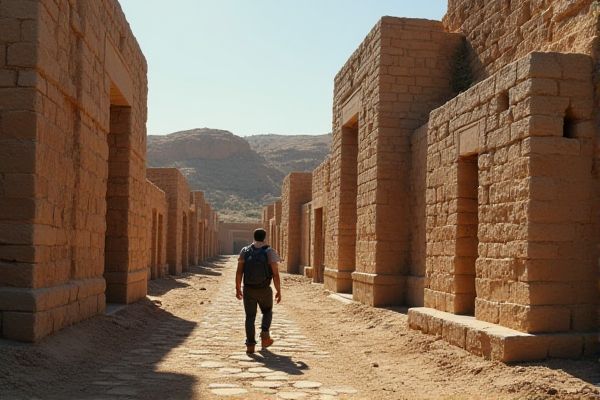
AI enhances archaeological research by analyzing vast datasets from dig sites, allowing for quicker insights into historical patterns and artifacts. Machine learning algorithms can identify features in satellite imagery, revealing potential excavation sites that might otherwise go unnoticed. In heritage preservation, AI tools help in the restoration of damaged artifacts by predicting the original appearance of items based on existing fragments. By automating routine documentation processes, AI frees archaeologists to focus on interpretation and the significance of their findings.
AI usage in archaeology and heritage preservation
Predictive Modeling and Site Discovery
AI can enhance archaeology and heritage preservation by using predictive modeling to identify potential excavation sites. For example, researchers can analyze satellite imagery and topographical data to locate areas rich in historical artifacts. This approach increases the chances of discovering significant archaeological sites before traditional excavation methods are employed. The integration of AI technologies may lead to more efficient resource allocation and reduced costs for institutions like museums and universities engaged in heritage conservation.
Artifact Recognition and Classification
AI can enhance artifact recognition and classification in archaeology, improving the accuracy of identifying ancient objects. For instance, by employing machine learning algorithms, researchers can streamline the process of cataloging items at institutions like the British Museum. This technology has the potential to uncover patterns in artifacts that may have been previously overlooked. Increased efficiency in analysis may lead to better preservation strategies and insights into historical contexts.
Digital Reconstruction and Virtual Tours
AI can enhance archaeology and heritage preservation by providing tools for digital reconstruction of ancient sites. For example, institutions like the British Museum utilize AI to create immersive virtual tours, allowing users to explore artifacts and historical landscapes from anywhere in the world. This technology can also facilitate detailed analysis of archaeological data, increasing accuracy in understanding past civilizations. The combination of these advancements offers the potential for greater public engagement and educational opportunities in the field.
Data Management and Analysis
AI can enhance data management and analysis in archaeology by automating the processing of large datasets, such as satellite imagery or excavation records. This technology can identify patterns and anomalies that may not be visible to human researchers, potentially leading to more efficient site discoveries. For instance, predictive modeling could help refine the search for ancient ruins based on historical climate data. The integration of AI tools in institutions like the British Museum offers opportunities to optimize preservation techniques and improve accessibility to cultural heritage.
Deterioration Monitoring and Conservation
AI technologies can enhance deterioration monitoring in archaeology by analyzing images or sensor data to detect changes in artifacts and structures. For instance, using AI models, institutions like the British Museum can predict how environmental factors may affect their collections. This proactive approach to conservation allows for timely interventions, potentially reducing the long-term damage to important heritage sites. The incorporation of machine learning algorithms could lead to more efficient resource allocation in preservation efforts.
Language Translation and Deciphering Inscriptions
AI has the potential to enhance archaeology and heritage preservation by automating language translation and deciphering inscriptions. For instance, institutions like the British Museum can utilize AI algorithms to analyze ancient texts more efficiently. This technology may uncover previously lost meanings and connections in historical artifacts. Increased accuracy in translation could lead to a deeper understanding of ancient cultures and practices.
Remote Sensing and Geospatial Analysis
AI has the potential to enhance archaeology and heritage preservation by improving data analysis and interpretation. Techniques like remote sensing can help archaeologists identify hidden sites without invasive digging, increasing efficiency in fieldwork. Geospatial analysis enables researchers to visualize and understand the spatial relationships of artifacts, leading to better-informed decisions. Institutions like the Getty Conservation Institute have begun to integrate these technologies to preserve cultural heritage effectively.
Public Engagement and Educational Outreach
AI can enhance archaeological research by analyzing vast datasets, potentially revealing new insights into ancient societies. For instance, institutions like the British Museum use AI to engage the public by creating interactive experiences that bring history to life. The possibility of using AI for predictive modeling could also assist in site preservation by identifying areas most at risk from environmental factors. Such advancements might increase public interest and education in heritage preservation, fostering a greater appreciation for cultural history.
Simulation for Excavation Planning
AI can enhance archaeology and heritage preservation by optimizing excavation planning through simulation techniques. These simulations can predict the most likely locations of artifacts, thus increasing the chances of successful digs. For example, institutions like the Archaeological Institute leverage AI models to analyze site data effectively. This approach allows archaeologists to allocate resources more efficiently, potentially leading to the discovery of significant historical finds.
Enhanced Documentation and Archiving Techniques
AI can significantly improve documentation and archiving techniques in archaeology, allowing for more efficient data management and analysis. By utilizing machine learning algorithms, researchers can automate the categorization of artifacts, enhancing retrieval processes. For example, institutions like the British Museum are exploring AI to digitally preserve their collections, ensuring greater access and understanding. The potential for AI to analyze patterns in large datasets also opens opportunities for new insights into historical contexts.
 techknowy.com
techknowy.com